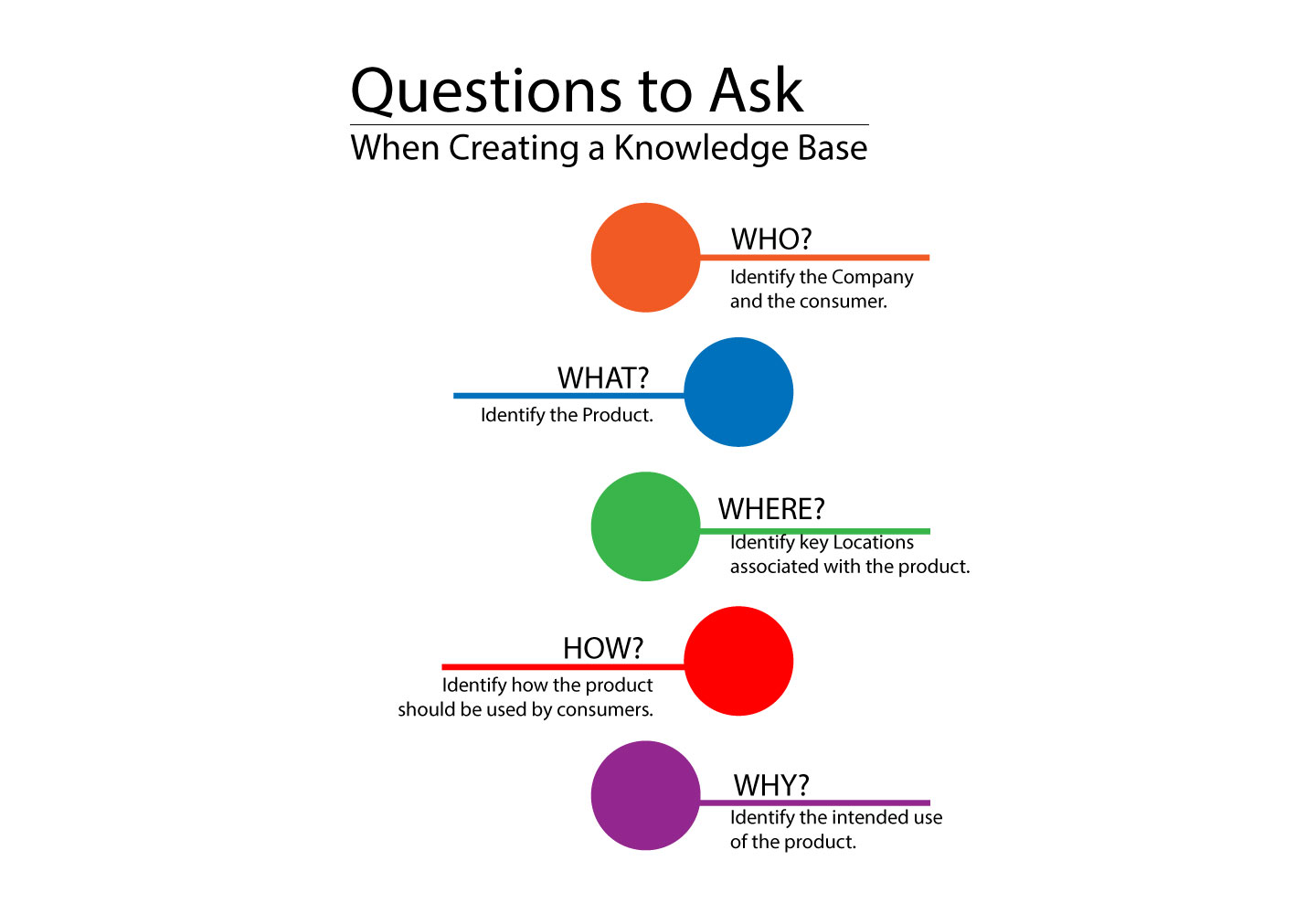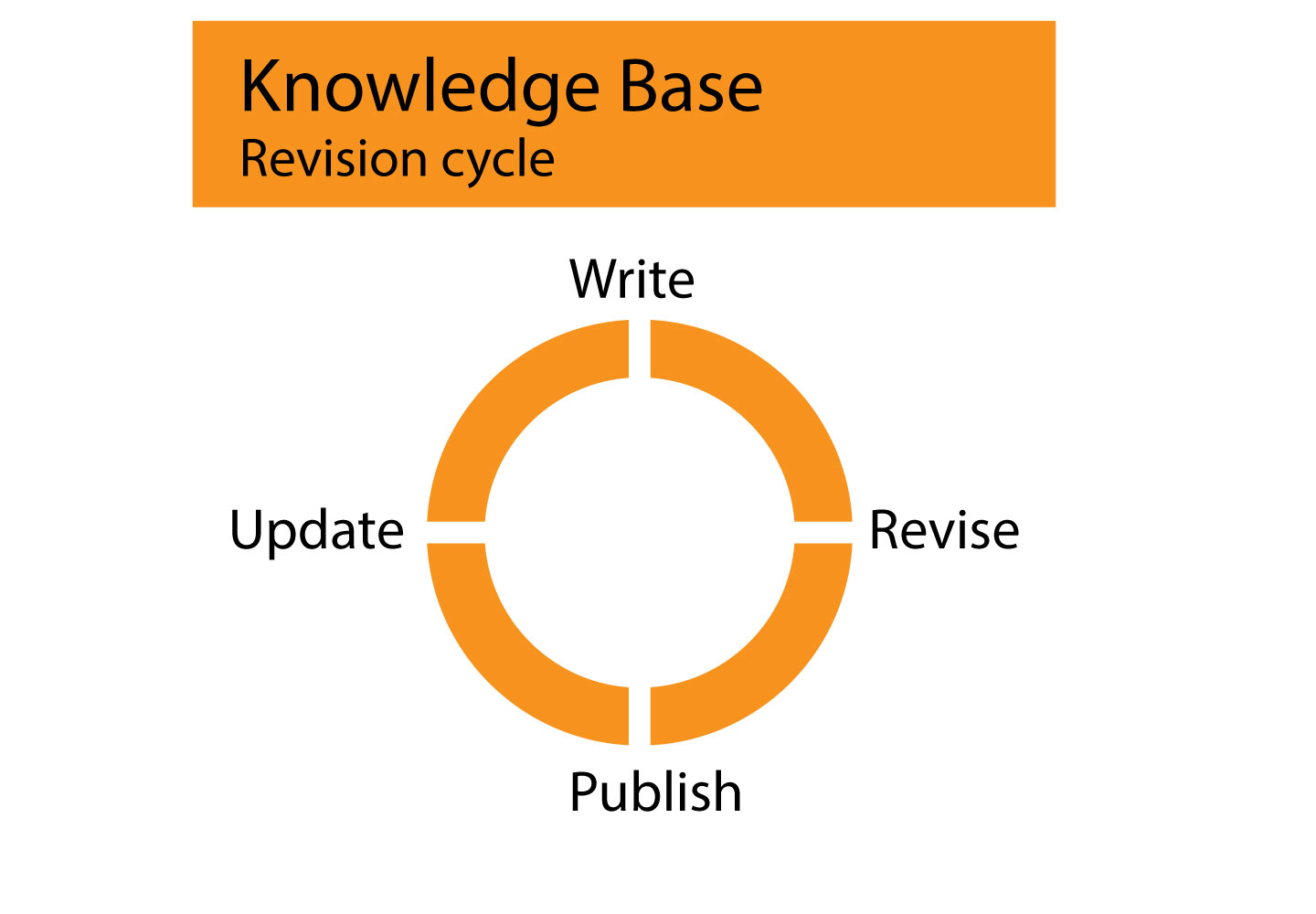Messaging applications are not the only technological trend companies have used to begin addressing consumer needs for using products. A large number of companies have also begun to discover that written correctly, a support knowledge base can be particularly helpful. It is important for companies to understand, however, that a strong knowledge base can comprise one of the main elements in company efficiency. The other elements of efficiency that substantially help companies improve operations involve positioning employees to best understand the needs of customers and then continuing to efficiently adapt the company’s knowledge base as influenced by leading trends.

Positioned in the center of the key efficiency elements in this graph, the support knowledge base can be very helpful for a company’s efficiency and ultimate growth. Among the many advantages, a strong knowledge base can help a company operate in a much more efficient manner. McKinsey and Company have even found employees spend 20% of their time searching for answers for consumer questions. These wasted resources result in companies in the United States losing $41 billion each year because customer service departments do not work in the most efficient manner. Without as many direct calls from customers, companies are able to save a large number of man-hours. Many customers also find knowledge bases particularly rewarding because they find knowledge bases a much quicker way of obtaining answers.
Zendesk reports that 91% of consumers would use a knowledge base if it were correct. Writing a strong knowledge base, however, can be very challenging. The downside is if a knowledge base is not properly created, a company is at risk of not making their operation more efficient because customers won’t find the document helpful. There is even a risk customers will become so upset over a poor knowledge base that customers will seek the services of a competitor.
Creating a strong knowledge base, however, can prove to be particularly challenging for a company. The purpose of this article is to describe nine pieces of strategic advice that companies can implement when creating a knowledge base to make sure their knowledge base ends up as strong as possible.
Strategy #1 – Create A Plan
The best way to begin creating a support knowledge base is to create a plan before taking any concrete steps. This plan should include details about how the knowledge base will be organized. Because knowledge bases can grow extensively, without a good structure, a company is at risk of having a large piece of information that is very difficult for consumers to navigate. The graph below represents just one of the many ways companies can structure their plan for the creation of a knowledge base: identify customers, determine how these customers communicate, structure how questions will be answered in the knowledge base, and then hire staff to write the knowledge base.

While these four elements should each be considered by a company in creating a knowledge base, it is a wise idea to plan each of these goals in sufficient details. It is also important to remember this plan will act as a just a guide for how the base will be created and some unseen events might cause a company to have to adjust this plan. For example, as a company begins to create a structure for a knowledge base, the company might realize it is better to structure the tasks in a different order.
As a result, companies should aim to create a knowledge base that can be easily understood by consumers.
Sufficient planning must be conducted prior to create a knowledge base. If adequate research is not conducted, consumers will likely grow frustrated because information will not be presented in the most easy to navigate way.
There are many complicated problems that must be solved to create a strong knowledge base. While the written content in the knowledge base must be direct and sufficiently answer a consumer’s questions, there are also many other problems that can arise. One of the most common challenges involves various types of computer coding required to properly structure the knowledge base.
Many companies have discovered the best way to plan a knowledge base is to listen to the opinions of various individuals from varying departments at the companies. Each of the concerns these individuals have concerning a knowledge base should be sufficiently addressed.
Strategy #2 – Reflect Customer Questions in a Support Knowledge Base
Any successful knowledge base should be written with an understanding of the audience. For example, a knowledge base should be written in a friendly tone and use words that can easily be understood by a consumer. One of the best pieces of advice for a company interested in creating an engaging knowledge base is to anticipate the types of questions that customers most frequently ask.

These are just some of the most common question areas asked by consumers. In recognition of what questions are most often asked by customers, many companies choose to structure knowledge bases. While not every consumer is likely to find this structure helpful, a large number of consumers do.
Strategy #3 – Learn How to Structure Your Support Knowledge Base
It is vital a company structures its knowledge base in the best possible manner. Failure to do so can leave out important steps in how a consumer should use a product. There are several important questions a company or the writer hired for a company to create a knowledge base should consider. The graphic below illustrates exactly what questions should be asked to define the relationship consumers have with a product.

In addition to answering these five questions, it is important companies create documentation that is as clear and comprehensive as possible. A knowledge base should even explain the product to consumers who might have never heard of the product. It is also important for a support knowledge base to teach consumers about how to use a product appropriately and safely.
A knowledge base should contain teaching elements. Consumers who read a knowledge base should be able to learn how to successfully use a product. In teaching the consumer, companies should realize different individuals learn in different ways. While some individuals learn best by diagrams, others learn best by processing articulate step-by-step directions. There are various types of software that can help companies create instructions or screenshots, which can greatly enhance a consumer’s understanding of how to safely use a product.
Strategy #4 – Properly Manage a Knowledge Base
Companies should manage a knowledge base like it is a department or product line. As a result, companies should make regular changes to the knowledge base. It is also important to identify which consumers are most likely to use a knowledge base to make sure the document is likely to satisfy the consumer’s demands. The graphic below highlights a strong potential framework for how companies should maintain and revise a support knowledge base

Not only is dedicated management of a support knowledge base particularly important, but companies should also make sure to stick to a schedule to regularly review and update content. For example, a company might decide to review its knowledge base once every three months. Sticking to this type of schedule can help companies remedy problems in the knowledge base before these issues are noticed by consumers. These updates can also make sure the guide contains new data that might arise due to new products or revisions to existing products.
Strategy # 5 – Create A Way To Measure Customer Satisfaction
It is important that companies create a metric to assess to what degree consumers are satisfied with a knowledge base. Being able to demonstrate that consumers are satisfied with a knowledge base helps convince top management at a company to spend resources on further developing a knowledge base. The graphic below illustrates just some of the most popular ways that companies measure the satisfaction of customers.

No matter what exact method is chosen to measure how content customers are with a knowledge base, it is important a company implements at least one of these methods to obtain further funding. Creating a way to measure the success of a knowledge base can also help companies determine what problems exist in managing the base. By fully understanding what elements of a knowledge base confuse a consumer, companies can take the proper steps to adequately fix these problems and ultimately increase customer satisfaction.
Strategy # 6 – Utilize A Style Guide While Creating The Knowledge Base
By using an established style guide to determine how bullets and phrasing should be utilized, a company can make sure the tone of the knowledge base is consistent. Sometimes, companies already have style guides can prove essential in creating a knowledge base. Software like MailChimp can be very helpful in establishing a fun and colloquial tone among consumers.
The exact tone should also to some degree be influenced by the type of product that is involved. A medical tool might require technical words, while a video game console would likely not require as professional a tone.
Formatting can also greatly increase how easily and quickly consumers can read and process an article. Some formatting tips include bold text, bullet-point lists, large headers, simple titles, and tables. Formatting and tone revisions should be made to a page as a company continues to redefine and sharpen its knowledge base. The diagram below represents the cycle with which companies should approach each page.

By using the pattern of constant improvement suggested by this graphic, companies can continue to make sure their knowledge base strengthens gradually as time progresses.
Strategy # 7 – Properly Used Visuals
Consumers can be discouraged from reading a knowledge base if the document only contains long blocks of texts. Frequent paragraph breaks but more importantly visuals help to make text much more digestible.
In addition to pictures, some companies decide to place informational videos in their knowledge base. If a company does decide to use in their video, however, it is a wise idea to also use an accompanying visual.
Companies who do use pictures tend to either obtain these images from one of the company’s social media accounts or sometimes even encourage employees to take pictures that can be used.
Strategy # 8 – Determine The Company’s Minimum Viable Product
To create a strong knowledge base, it is important companies understand what a “minimum viable product” is. This term refers to earlier versions of a company’s newest release. Minimum viable products allow companies to experience the highest return relative to risk. The illustration below represents the cyclical nature between production creation, product use, and research involved with a minimum viable product.

This cycle should also be applied to how a company treats a minimum viable product. Instead of trying to create a perfect group of information from the beginning, companies should view the process of creating a knowledge base as neverending.
Step # 9 – Determine What Obstacles Users Will Encounter
To obtain the strongest knowledge base possible, a company must anticipate all of the issues that might be raised by a customer. Thinking of each one of these obstacles is often a very challenging task.
Many companies find it helpful to begin creating a comprehensive base by projecting an average consumer for the product. The company is then able to describe common obstacles faced by the users and the critical steps a consumer must take to obtain value from a product. The illustration below illustrates some of the important questions a company must ask when determining what makes up their average consumer and that consumer’s shopping.

Answering the various questions about consumers can be particularly challenging and leave companies uncertain about how to answer each option. As a result, some companies even film test footage of a consumer using a product to see what obstacles the consumer encounters. Other companies asks acquaintances to use a product and then ask the friend to describe any obstacles that arose while using the product.
If a product has existed for a time, companies find it helpful to review a product support line to address common issues that arose from using the item. While this type of review can be very time-consuming, many companies have discovered this type of review can result in a very comprehensive knowledge base.
Conclusion
When a company creates a knowledge base, it is important to keep these various strategies in mind. Some companies are not certain why it might be preferable to create a knowledge base. The reality is that these sources of information have to make money for a company because the company will ultimately have to spend last time taking steps to obtain the necessary information. Therefore, a good knowledge base can be a very cost-effective way for a company to address issues that arise.












